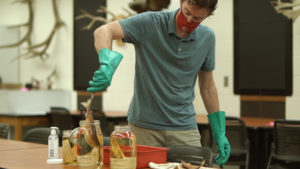Study offers key takeaways from long-term research on aquatic invasive species

A rock covered with invasive zebra mussels taken from Lake Mendota. Photo: Adam Hinterthuer, University of Wisconsin-Madison
By Adam Hinterthuer and Madelyn Anderson, University of Wisconsin-Madison
A report on more than 40 years of research on Wisconsin lakes highlights lessons scientists have learned about aquatic invasive species. For example, far more ecosystems are playing host to non-native species than were previously thought. However, the authors write, those species aren’t necessarily detrimental to their new habitat and, in some cases, the negative “impacts of invasive species control [efforts] may be greater than the impacts of the invasive species” themselves.
That doesn’t mean we shouldn’t be concerned about different species moving into new ecosystems, said Jake Vander Zanden, director of the University of Wisconsin-Madison’s Center for Limnology and lead author on the report. “There are many examples where an invasive species has remarkable ecosystem impacts. They can result in fisheries decline, water quality decrease, and more which negatively impacts humans and the environment,” he said. But ecological destruction is far from a foregone conclusion in invasive species stories.
In the article, published recently in the journal “BioScience,” Vander Zanden and his team, which includes Alison Mikulyuk, Sea Grant’s Water@UW Madison Research Program coordinator, highlight nine lessons learned through four decades of data collection, research and experiments conducted by the North Temperate Lakes Long-Term Ecological Research Program. Housed at the Center for Limnology, the NTL-LTER is one of 27 long-term research sites funded by the National Science Foundation.
Research grants are typically funded for three years, Vander Zanden explains, “But that would never allow you to detect these types of changes. It’s only through long-term research that we can get insights into these big questions like where invasive species are, how they are changing our ecosystems and how it all connects to things like climate change.”
One such insight is that the presence of non-native aquatic species in Wisconsin lakes is more widespread than scientists and resource managers initially thought. The NTL-LTER has helped inform Wisconsin Department of Natural Resources maps and datasets on six target species – Eurasian watermilfoil, zebra mussels, spiny waterfleas, rusty crayfish, Chinese mystery snail and the banded mystery snail – since the 1990s.
Combining long-term monitoring records on its 11 core study lakes with field-based research and community-based science on dozens of other water bodies, researchers revealed that existing estimates of about 8% of Wisconsin lakes containing one or more of the six species was way off. In fact, the number is closer to 39%.
The post Study offers key takeaways from long-term research on aquatic invasive species first appeared on Wisconsin Sea Grant.Blog | Wisconsin Sea Grant
https://www.seagrant.wisc.edu/blog/study-offers-key-takeaways-from-long-term-research-on-aquatic-invasive-species/

